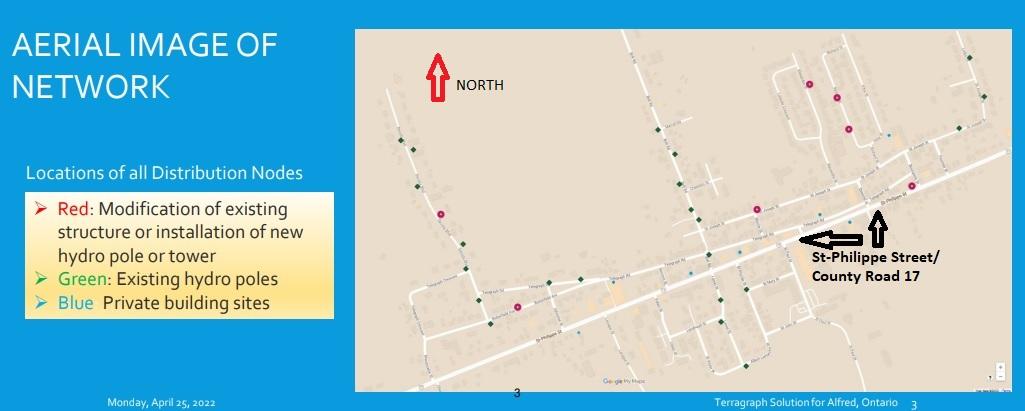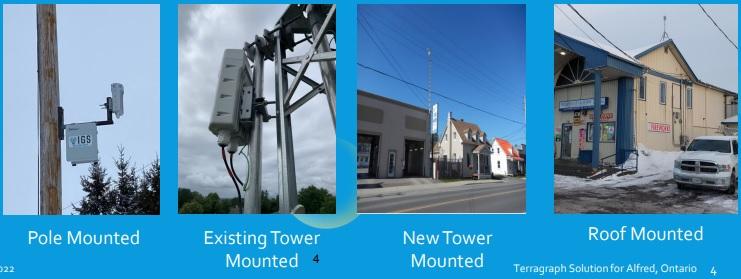Even though a plan to bring higher quality high-speed wireless internet access to Alfred is considered completely safe by regulators and is being welcomed by the municipality, some residents are opposing the proposal.
IGS Hawkesbury is proposing to install a terragraph system of 28 antennas on around the town which will relay internet access to home and business customers from a fiber-optic cable located near the water tower. The system operates on 60 gigahertz (GHZ) and is not a 5G system.
According to IGS, the electromagnetic emissions produced by a terragraph system are less than one per cent of maximum permitted by Health Canada Safety Code 6. Terragraph point to point systems emit less than eight per cent of the limit set out in Safety Code 6.
However, the residents of Devista Boulevard are concerned that the electromagnetic frequency of the antennas will lead to increased or worsened medical conditions, including cancer, reproductive difficulties, heart palpitations, and neurological disorders. A petition containing 12 signatures of Devista Boulevard residents opposing the antenna has been presented to the Township of Alfred and Plantagenet.
Resident Carolle Rose said she is concerned about the effects of the waves being transmitted by the antennas. The federal regulations on limits to exposure of radiofrequency electromagnetic energy from broadcast and telecommunications transmitters were last updated in 2015 and cover three to 300 GHZ. Rose said those regulations are now out of date and should be updated to reflect more recent studies. Rose referred to the work of McGill University Professor Paul Heroux on the effects of electromagnetism from 5G networks as an example. The Review contacted Professor Heroux for comment but did not receive a response by the time of publication.
Even though the proposed antennas for the non-5G Alfred network fall within the federal regulations, Rose is not convinced it is safe.
“You have to be concerned about it,” she said.
Rose’s neighbour George Comitsis wants to wait until the technology is proven to not seriously affect human health.
“It’s too new and I don’t’ trust it. It’s too close to our residence,” he said.
Comitsis said even though the proposed network falls within federal regulations, it does not mean it is totally safe.
“Acceptable does not mean safe, 100 per cent,” he remarked.
On May 17, IGS Hawkesbury Outside Plant Manager Ron Ziernicki and President Jamie Bogue presented their plan to Alfred and Plantagenet Council. They emphasized the required Innovation, Science, and Economic Development Canada (ISED) public consultation process will be followed. According to Alfred and Plantagenet Chief Administrative Officer (CAO) Michel Potvin, the project was also discussed at the December 1, 2020, and June 15, 2021, council meetings.
Ziernicki told council the antennas will be located on existing utility poles, and a small tower. The tallest pole will be 35 feet.
When Ziernicki and Bogue made their presentation to council, there were only positive comments in response. Councillors Ian Walker and Antoni Viau were both more interested in if the service would be extended to other villages and rural areas of the municipality.
Bogue said expansion would not be possible, as they are still waiting for ISED to open more digital spectrum for rural areas.
“It’s very interesting to see some our people are going to be getting some services sooner and better than later,” said Pro-Mayor Yves Laviolette.
In an interview with The Review, Bogue emphasized what is being proposed in Alfred is not 5G and is rather like the technology used for home Wi-Fi.
“This is not 5G at all,” he said.
Bogue also emphasized Canada has high safety standards for electromagnetic radiation.
“Our regulations are some the strictest in the world,” said Bogue.
The reason IGS has chosen to develop the system in Alfred is simple.
“We had an immense demand for service there,” Bogue said.
Efforts have been made to ensure the antennas are as inconspicuous as possible. Bogue said that if residents are opposed to an antenna being placed on their street, it is not possible to relocate it to another place, because it would disrupt service on the network.
Under the ISED-mandated public consultation process, 69 properties within 150 metres of each proposed antenna were notified by mail of the project on June 17, 2022. IGS, not the township, is responsible for the consultation process and any concerns are to be addressed by when the process ends on July 24. Under federal regulations, IGS will also be required to submit annual reports on the performance of each antenna.

Map showing locations of antennas under IGS plan in Alfred. Illustration from IGS presentation to Alfred and Plantagenet Township Council.


